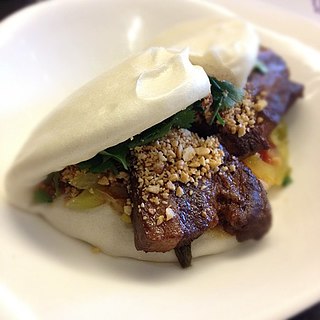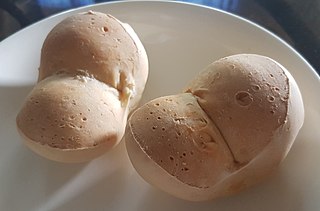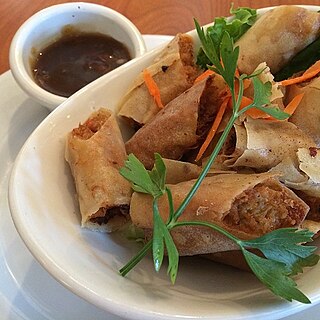
A sausage roll is a savoury dish, popular in current and former Commonwealth nations, consisting of sausage meat wrapped in puff pastry. Although variations are known throughout Europe and in other regions, the sausage roll is most closely associated with British cuisine.

Meatloaf is a dish of ground meat that has been combined with other ingredients and formed into the shape of a loaf, then baked or smoked. The final shape is either hand-formed on a baking tray, or pan-formed by cooking it in a loaf pan. It is usually made with ground beef, although ground lamb, pork, veal, venison, poultry, and seafood are also used, sometimes in combination. Vegetarian adaptations of meatloaf may use imitation meat or pulses.

Ukrainian cuisine is the collection of the various cooking traditions of the people of Ukraine, one of the largest and most populous European countries. It is heavily influenced by the rich dark soil (chornozem) from which its ingredients come, and often involves many components. Traditional Ukrainian dishes often experience a complex heating process – "at first they are fried or boiled, and then stewed or baked. This is the most distinctive feature of Ukrainian cuisine".

Czech cuisine has both influenced and been influenced by the cuisines of surrounding countries and nations. Many of the cakes and pastries that are popular in Central Europe originated within the Czech lands. Contemporary Czech cuisine is more meat-based than in previous periods; the current abundance of farmable meat has enriched its presence in regional cuisine. Traditionally, meat has been reserved for once-weekly consumption, typically on weekends.

Char siu bao is a Cantonese baozi (bun) filled with barbecue-flavored cha siu pork. They are served as a type of dim sum during yum cha and are sometimes sold in Chinese bakeries.

Siopao, is a Philippine steamed bun with various fillings. It is the indigenized version of the Fujianese baozi, introduced to the Philippines by Hokkien immigrants during the Spanish colonial period. It is a popular snack in the Philippines and is commonly sold by bakeries and restaurants.

Choripán is a type of argentine asado sandwich with grilled chorizo popular in Argentina, Chile, Uruguay, Paraguay, Peru, Bolivia and Venezuela. The name comes from the combination of the names of its ingredients: a grilled chorizo sausage and a crusty bread such as a pan batido, baguette, or francés.

Chilean cuisine stems mainly from the combination of traditional Spanish cuisine, Chilean Mapuche culture and local ingredients, with later important influences from other European cuisines, particularly from Germany, the United Kingdom and France. The food tradition and recipes in Chile are notable for the variety of flavours and ingredients, with the country's diverse geography and climate hosting a wide range of agricultural produce, fruits and vegetables. The long coastline and the peoples' relationship with the Pacific Ocean add an immense array of seafood to Chilean cuisine, with the country's waters home to unique species of fish, molluscs, crustaceans and algae, thanks to the oxygen-rich water carried in by the Humboldt Current. Chile is also one of the world's largest producers of wine and many Chilean recipes are enhanced and accompanied by local wines. The confection dulce de leche was invented in Chile and is one of the country's most notable contributions to world cuisine.

Touton is a traditional dish from Newfoundland, most usually thought of as a pancake-like bread dough commonly made with risen dough. Although pancakes are rarely made from homemade bread dough in Newfoundland, the memory of regional terms still exists in younger generations, such as the British English term tiffin, meaning "small lunch". The dish has a long list of regionally-distinct names, and can refer to two different types of baked or fried dough: the dough cake variant, usually fried; and a baked bun variant, made with pork fat. Toutons are usually served at breakfast or brunch and are on the breakfast menus of many local restaurants.

A meatball is ground meat (mince) rolled into a ball, sometimes along with other ingredients, such as bread crumbs, minced onion, eggs, butter, and seasoning. Meatballs are cooked by frying, baking, steaming, or braising in sauce. There are many types of meatballs using different types of meats and spices. The term is sometimes extended to meatless versions based on vegetables or fish; the latter are also commonly known as fish balls.

A gua bao, also known as a pork belly bun, ambiguously as a bao, or erroneously as a bao bun, is a type of lotus leaf bun originating from Fujian cuisine. It is also a popular snack in Taiwan, Singapore, Malaysia, Philippines, and Nagasaki Chinatown in Japan.

Tangzhong, also known as a water roux or yu-dane is a paste of flour cooked in water or milk to over 65 °C (149 °F) which is used to improve the texture of bread and increase the amount of time it takes to stale.

Monay, also known as pan de monja, is a dense bread roll from the Philippines made with all-purpose flour, milk, and salt. It has a characteristic shape, with an indentation down the middle dividing the bread into two round halves. It is a common humble fare, usually eaten for merienda with cheese or dipped in hot drinks.

Lumpiang shanghai, is a Filipino deep-fried appetizer consisting of a mixture of giniling wrapped in a thin egg crêpe. Lumpiang Shanghai is regarded as the most basic type of lumpia in Filipino cuisine, and it is usually smaller and thinner than other lumpia variants.

Philippine asado refers to two different Filipino braised meat dishes. The name originates from Spanish asado ("grilled"), a reference to the original dish it was applied to, the Chinese-Filipino version of char siu barbecues usually known as pork asado. However, the Filipino versions have evolved to be braised, not grilled. The other Filipino dish also known as asado is asado de carajay. Unlike the Chinese-derived version, it is savory rather than sweet.
















